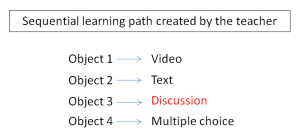I’m working a on project where we want to offer our students online learning paths which are adapted to their needs and thus take into account the very diverse student inflow we encounter. Although I wrote this text with the previous objective in mind, it can be applied to other learning situations as well.
How ‘traditional learning paths’ work:
After a teacher creates and/or collects learning objects, he can start to bundle or sequence learning objects into learning paths. Most LMS (Learning Management Systems) only allow sequential learning paths, resulting in rather static designs and non-dynamic user-experiences. For example: if the teacher wants to leave room for discussion, a link to a separate tool can be added (e.g. a forum). Learners clicking on this link will leave the learning path tool, and start/continue a discussion in a separate (discussion) tool. Such a work around doesn’t work on mobile and is not user-friendly, but hey, LMS are pre-year 2000 technology after all.
How learning paths should work (1)
First, all learning objects should be accompanied on the object level by the possibility to annotate them, to like them and to discuss them; by both teachers and learners. Note that the discussion functionality is now integrated on the object level.
How learning paths should work (2)
Second, teachers will always be good content curators, but we should invite learners to add or create their own learning objects.
Third, tool-use literature shows that the ‘right tool’ for learner A might be completely useless for learner B. And even more, as learner A becomes more experienced, his tool preference might change as well (e.g. in the beginning learner A feels more comfortable watching videos, but later on A likes to read articles and be involved in discussions). Conclusion: we should offer a wide range of learning objects.
How learning paths should work (3)
Fourth, based on the annotations, the discussions and likes a learning object is associated with, a learner should be able to design his/her own learning path. But other choices could be interesting as well. Learner A could be a student who wants to stick with the learning path as proposed by the teacher, while learner B likes to follow the choices made by learner C (maybe the smartest kid in class, are just someone with a similar learning profile).
Ok nice, but can we use the learning path tool in our current LMS? (please read the post)
And what is the role of the teacher?
We will answer these questions n the following blog posts.





2 thoughts on “Rethinking learning paths: conceptual design”